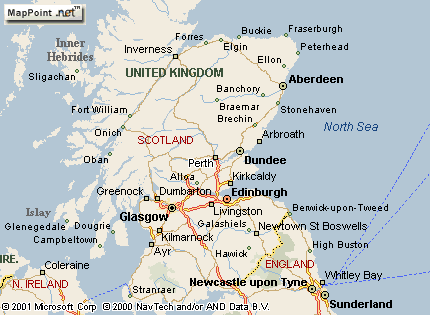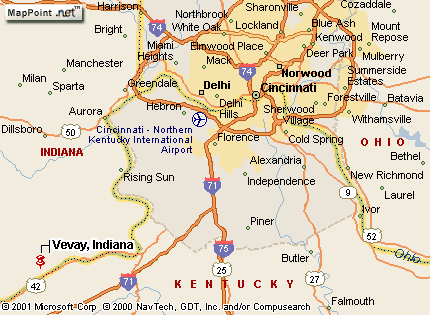1784 – 1832
The following information was taken from “The Argent Castle”, the Newsletter of the Clan MacCallum/Malcolm Society. It is undated, but written by Robin Neill Lochnell Malcolm, D. L. Chief. While great reading, the accuracy of the information is unknown.
“It is thought the McCallums emigrated from Perthshire and that their father’s name was John. A daughter Elinor is said to also have emigrated, but there is no information on her: could she have remained in New York, or have gone to Canada?


Duncan
One of the sons is said to have graduated from Edinburgh University in 1802 and soon after made a trip to Paris, where he met Robert Fulton. This must have been Duncan, who later had his own steamboat on the Ohio. James Tillotson says that Fulton was in Paris at that time and operated a steamboat on the Seine River. It is also thought that Duncan was in New York when Fulton sailed the Clermont up the Hudson a couple of years later. At any rate, Duncan was in Indiana by 1815, when he bought land, and by 1819 was building his steamboat, the Hieland Laddie, which made regular runs between Vevay and Cincinnati – a distance of 100 miles, taking two days and two nights to complete the trip.

Duncan also established with the Tafts (ancestors of President Robert A. Taft), a steamship line, the first on the Ohio River. The business must have been prosperous as Duncan owned a home in Cincinnati and a summer place at French Lick, a well-known spa. After his death at age 48 in 1832, most of his assets were lost in litigation, possibly pertaining to the steamboat business. To keep the family going, the sons set up a steam sawmill at Long Run.
Duncan had married Ellen Guthrie (“of a Pennsylvania Revolutionary family”) and they had five children. The first two sons (born before 1820) left for the gold rush in California, arriving in San Francisco on the Ohio in 1851. They are named “D” and “M” on the passenger list; in 1852 word was received in Indiana that they were ill and Ellen sent younger son John Guthrie, who had graduated from the University of Indiana Law School and begun his practice, to bring his brothers home. By the time his ship arrived in 1854, he found both had died, but seeing the opportunities for legal work around Placerville, John G. decided to stay on.
From James Tillotson, we now know that John’s sister, Jane Stuart McCallum, also came to Placerville, probably to nurse the ill brothers. She was married there January 1, 1862, to the “handsome, gun-toting deputy sheriff,” John Dick Van Eaton.
From the notes of James Tillotson:
The Life and Times of Duncan MacCallum (ca. 1784-1832)
John MacCallum of Perthshire, Scotland, was the father of three sons, John, Neil and Duncan, all of whom emigrated to America, and one daughter, Elinor or Eleanor, who is only known of from a family bible owned by a descendent of Neil MacCallum. Duncan MacCallum was born ca. 1784 in or near Dundee, Scotland. Duncan is said to have graduated from Edinburgh about 1802 and shortly thereafter traveled through Europe on the Grand Tour. While in Paris he met Robert Fulton. So entranced was he with Fulton’s stories of these United States and experiments with steam boats that he emigrated in 1805. He was a passenger on the Fulton’s “Clermont” on its maiden voyage up the Hudson River (New York) in 1807. He married Ellen Guthrie, said to be from Pennsylvania and of Revolutionary stock, sometime prior to 1820. This suggests that he may have spent some time in Pennsylvania, perhaps after leaving New York and before going to Indiana.
John, Neil and Duncan MacCallum along with a number of other Scottish emigrants settled in Long Run in Southeastern Indiana prior to Indiana statehood (1816), Neil possibly being there as early as 1813 and Duncan purchased land in 1815 (and in 1819), but may not have settled there until 1817 or later. They were known as Seven(th) Day Baptists. “Traveling up ‘Long Run’ on a Saturday it was rather novel to the citizens to see none of these people stirring, but on Sunday everyone would be out clearing, chopping, piling and burning brush and rolling logs” (Dufour, 1925). Duncan later established, with the Tafts, the first steamship line on the Ohio River and was the Captain of the “Highland Lassie”, built in 1819-1821 possibly by Fulton, which traveled from Vevay (pronounced vee-vee) IN to Cincinnati OH. He must have been a successful business man as he owned a farm in Long Run IN, town residence in Cincinnati and a summer home in French Lick IN as well as his steam boat(s). After he died on 15 November 1832 at the age of 48 years, however, a steam saw mill was erected on his property in Long Run in an attempt to hold on to the property, but his holdings were lost in litigation. Duncan was buried in the MacCallum Cemetery on his land in Long Run along with several relatives. His wife, Ellen, died in April 1878 in Vevay at age 62 years and 7 months.
Duncan and Ellen MacCallum had 5 (or possibly 6) children, at least four of whom migrated to California. The first two sons known to me only as “D” (may have been Duncan, since his father is referred to as “Duncan, Sr.”) and “M” were born between 1810 and 1820, went to California in ?1851 in search of gold and died in an epidemic of smallpox or cholera in 1854. They are buried in Sacramento CA. A third son, John Guthrie (1826-1897) at the request of his mother, closed his law practice in Indiana or Ohio in 1854 to search for his two brothers in California after they were reported ill, arriving very shortly after their deaths. But John Guthrie is also found in the Hangtown, later Placerville, California in 1850. Jane Stuart (1824-1874) went to California, possibly with her brothers D and M or with John Guthrie, settled in Hangtown (now Placerville) CA and in 1860 married the handsome, gun-toting, deputy sheriff, John Dick Van Eaton. Van Eaton was made famous by the Bullion Bend Robbery. Jane and John Dick eventually settled, and died, in San Jose CA.
John Guthrie later became prominant in California politics and the founder of Palm Springs CA where he died. Little is known of the other daughter, Elizabeth (1829-?), and only brief mention is made of Ephrain (? a nephew, rather than a son), said to be a dealer in fine arts and a husband of six wives. There is also a single mention of a second Jane Stewart (Stuart) who is said to have possibly died in infancy, her namesake above being born later.
Regardless of their finances, these MacCallums always considered themselves socially superior to others, and were inclined to broadcast their feelings frequently.
Jim Tillotson’s Research Notes on the McCallum Family (large file).